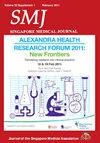Burnout among COVID-19 hospital-based contact tracers in Singapore: results of a mixed-method, cross-sectional multicentre study
IF 1.7
4区 医学
Q2 MEDICINE, GENERAL & INTERNAL
引用次数: 0
Abstract
During the coronavirus disease 2019 (COVID-19) pandemic, contact tracers were under immense pressure to deliver effective and timely contact tracing, raising concerns of higher susceptibility to burnout. Our study aimed to determine burnout prevalence among hospital-based contact tracers and associated risk factors, so that interventions to reduce burnout risk could be formulated. One hundred and ninety-six active contact tracers across three hospitals within a healthcare cluster were invited to complete an anonymous online survey. To identify burntout, data such as demographics, work-related variables and contact tracing-related variables were collected using the Copenhagen Burnout Inventory. Associated factors were identified using multivariate statistics. Open-ended questions were included to understand the challenges and potential improvements through qualitative analysis. A total of 126 participants completed the survey, giving a completion rate of 64%, and almost half of these participants (42.9%) reported burnout. Protective factors included being on work-from-home arrangements (adjusted odds ratio [OR] 0.22, 95% confidence interval [CI] 0.08–0.56), perception of being well supported by their institution (adjusted OR 0.25, 95% CI 0.08–0.80) and being married (adjusted OR 0.28, 95% CI 0.12–0.64). Risk factors included having an administrative role pre–COVID-19 (adjusted OR 3.62, 95% CI 1.33–9.83). Work-related burnout was related to being activated for more than 1 day in the preceding week (unadjusted OR 3.25, 95% CI 1.33–7.94) and multiple activations in a day (unadjusted OR 3.54, 95% CI 1.44–4.41). Biggest challenges identified by participants were language barrier (62.7%), followed by workflow-related issues (42.1%). Our study demonstrated burnout and other challenges faced by a team of mostly hospital-based administrative staff redeployed on a part-time basis to ensure timely contact tracing. To mitigate burnout, we recommend choosing staff on work-from-home arrangements and ensuring adequate manpower and rostering arrangements.新加坡 COVID-19 医院接触追踪员的职业倦怠:一项混合方法横断面多中心研究的结果
在 2019 年冠状病毒病(COVID-19)大流行期间,接触追踪人员面临着及时有效地开展接触追踪工作的巨大压力,这引发了他们更容易产生职业倦怠的担忧。我们的研究旨在确定医院接触追踪人员的职业倦怠发生率及相关风险因素,从而制定降低职业倦怠风险的干预措施。 我们邀请了一个医疗集团内三家医院的 196 名活跃的联络追踪员完成匿名在线调查。为了识别职业倦怠,我们使用哥本哈根职业倦怠量表收集了人口统计学、工作相关变量和接触追踪相关变量等数据。使用多变量统计确定了相关因素。调查还包括开放式问题,以便通过定性分析了解所面临的挑战和可能的改进措施。 共有 126 名参与者完成了调查,完成率为 64%,其中近一半(42.9%)的参与者报告了职业倦怠。保护因素包括在家工作的安排(调整后的几率比[OR]0.22,95%置信区间[CI]0.08-0.56)、认为得到所在机构的良好支持(调整后的几率比0.25,95%置信区间[CI]0.08-0.80)和已婚(调整后的几率比0.28,95%置信区间[CI]0.12-0.64)。风险因素包括在COVID-19之前担任行政职务(调整后OR为3.62,95% CI为1.33-9.83)。与工作相关的倦怠与前一周被激活超过 1 天(未调整 OR 3.25,95% CI 1.33-7.94)和一天内多次激活(未调整 OR 3.54,95% CI 1.44-4.41)有关。参与者认为最大的挑战是语言障碍(62.7%),其次是工作流程相关问题(42.1%)。 我们的研究表明,为确保及时追踪联系人而重新部署的兼职行政人员团队面临着职业倦怠和其他挑战。为减轻职业倦怠,我们建议选择在家工作的员工,并确保充足的人力和轮岗安排。
本文章由计算机程序翻译,如有差异,请以英文原文为准。
求助全文
约1分钟内获得全文
求助全文
来源期刊

Singapore medical journal
MEDICINE, GENERAL & INTERNAL-
CiteScore
3.40
自引率
3.70%
发文量
149
审稿时长
3-6 weeks
期刊介绍:
The Singapore Medical Journal (SMJ) is the monthly publication of Singapore Medical Association (SMA). The Journal aims to advance medical practice and clinical research by publishing high-quality articles that add to the clinical knowledge of physicians in Singapore and worldwide.
SMJ is a general medical journal that focuses on all aspects of human health. The Journal publishes commissioned reviews, commentaries and editorials, original research, a small number of outstanding case reports, continuing medical education articles (ECG Series, Clinics in Diagnostic Imaging, Pictorial Essays, Practice Integration & Life-long Learning [PILL] Series), and short communications in the form of letters to the editor.
 求助内容:
求助内容: 应助结果提醒方式:
应助结果提醒方式:


